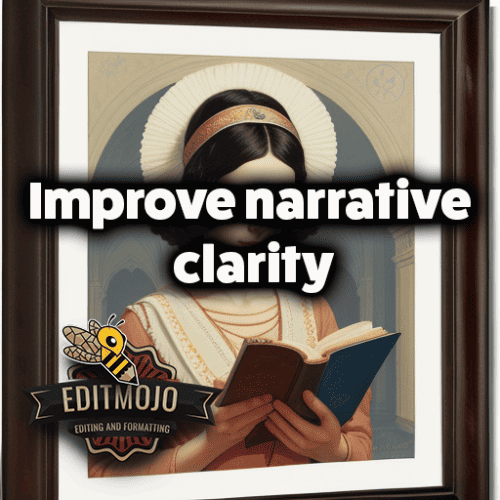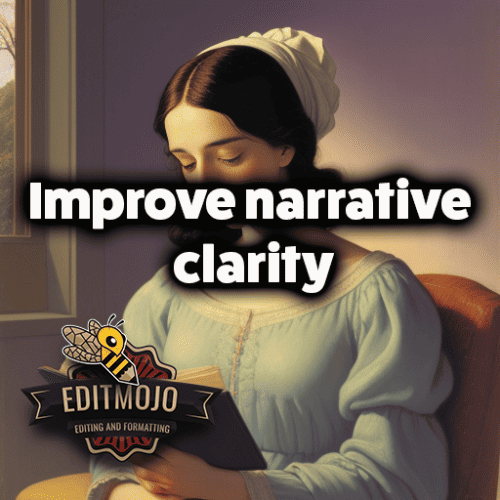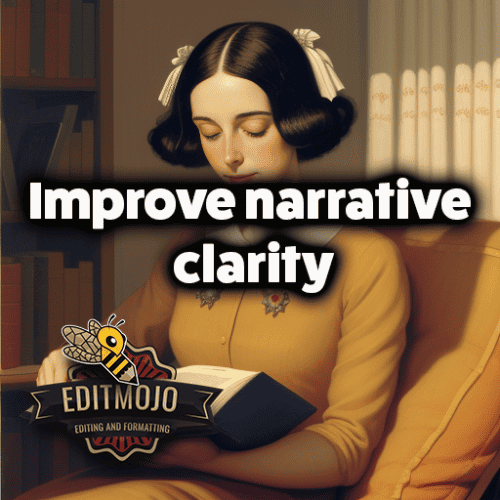Improve narrative clarity
Improve narrative clarity. Clarity in narrative is as crucial as the plot itself. It’s the beacon that guides the reader through the realms of imagination, ensuring they are not lost in the intricacies of the storyline. A narrative lacking clarity is like an unlit labyrinth, puzzling and frustrating for the reader.
In this post, we’ll delve into the enigma of narrative clarity, explore its building blocks, identify common pitfalls, and provide practical solutions to enhance it. Brace yourselves for a journey to the very heart of storytelling.
Key Takeaway Table
| Topic | Key Takeaway |
|---|---|
| Understanding Narrative Clarity | Clear narrative is not just about simple words but delivering plot, characters, and themes in an accessible manner. |
| Building Blocks of Narrative Clarity | Precision in language, clear structure, and consistency are vital for narrative clarity. |
| Common Pitfalls of Narrative Clarity | Overcomplication, poor pacing, and inconsistent character and plot development can hamper narrative clarity. |
| Improving Narrative Clarity | An outline, concise language, consistent development, and optimal pacing can enhance narrative clarity. |
| Role of Feedback and Technology | Feedback and modern software tools can be crucial in refining narrative clarity. |
Understanding Narrative Clarity
Narrative clarity is the art of delivering your story in a clear, comprehensive, and engaging manner. It isn’t merely about using simple words but ensuring the plot, characters, and themes are presented in a digestible and accessible manner.
For example, J.K. Rowling’s Harry Potter series^1^ is a perfect example of clear narrative. Despite the series’ complexity with various plots and subplots, Rowling manages to keep her narrative focused, leading the reader through a magical journey without confusion.

The Building Blocks of Narrative Clarity
There are three primary ingredients to brew the potion of narrative clarity: precision in language, clear structure, and consistency.
Language Precision
Precision in language implies choosing the most accurate words to express your ideas. It’s about finding that perfect word which conveys not just the meaning but the emotional nuance of the scene. It’s the difference between a character ‘walking’ and ‘sauntering’ or ‘striding’.
Clear Structure and Flow
A clear structure is the skeleton that gives your narrative body and form. It helps the reader navigate your plot without stumbling. Breaking your story into chapters, sections, or even paragraphs can provide much-needed reading checkpoints.
Consistency
Consistency is key in preventing narrative confusion. This includes consistency in character development, plot progression, and even writing style. Imagine if Sherlock Holmes suddenly started behaving out of character, it would disorient readers and muddle the narrative.
Common Pitfalls that Hamper Narrative Clarity
Some pitfalls can throw a wrench into the machinery of narrative clarity. Let’s identify them, so we can steer clear.

Overcomplication and Jargon
Avoid convoluted sentences and overuse of jargon. Your reader might not share your vast vocabulary, and nothing hampers clarity like a constant need to refer to a dictionary.
Poor Pacing
Too much happening too fast or too slow can confuse your readers or lose their interest. Balancing action with narration is crucial.
Inconsistent Character and Plot Development
Inconsistent character behavior or sudden unexplained plot twists can baffle readers. While unexpected developments are interesting, they need to make sense in the grand scheme of the narrative.
Practical Steps to Improve Narrative Clarity
Improving narrative clarity is a craft that can be mastered with the right steps. Here’s a roadmap to get you started:
Effective Planning and Outlining
An outline is your narrative’s blueprint. It provides a sense of direction and can help you maintain focus.
Precise and Concise Language Use
Remember, brevity is the soul of wit. Cut the fluff and keep it crisp. Using precise language doesn’t mean you have to eliminate complex words entirely, but they should be used sparingly and only when they best convey your meaning.
Consistent Character and Plot Development
Develop your characters and plot consistently. Readers appreciate growth and change when it is gradual and believable.
Achieving Optimal Pacing
Pacing is a subtle art. Practice different pacing techniques, learn to use cliffhangers, and interweave moments of action with reflection to keep your narrative clear and engaging.
Case Studies: Narrative Clarity in Action
Consider Ernest Hemingway’s The Old Man and the Sea^2^. The narrative is clear, concise, and straightforward, despite exploring deep themes. The story’s progression, the old man’s character development, and the simplicity of language make it a great example of narrative clarity.
Conversely, James Joyce’s Ulysses^3^, often cited as a challenging read, provides a sharp contrast. Its complex sentence structures, myriad references, and stream of consciousness style may create a high barrier for many readers, illustrating the impacts of narrative clarity (or lack thereof).
The Role of Feedback in Enhancing Narrative Clarity
Feedback can serve as a mirror, reflecting how your narrative is perceived by others. Be open to constructive criticism. Writing groups or professional editors can provide valuable insights into the clarity of your narrative.

Leveraging Technology for Narrative Clarity
Modern technology has blessed us with numerous tools to enhance narrative clarity. Software like Grammarly^4^ can help with grammar and sentence structure, while tools like Scrivener^5^ can assist with organizing your work for a clear narrative flow.
Conclusion (Improve narrative clarity)
Narrative clarity is a guiding light for your reader, illuminating the path through your story. By understanding its importance, avoiding common pitfalls, and employing the right strategies, you can create engaging, clear narratives that captivate your readers.
So, fellow wordsmiths, let’s embark on our journey to narrative clarity. Your readers are waiting.
Additional Resources (Improve narrative clarity)
To delve deeper into the craft of clear narratives, consider exploring resources like the works of Sol Stein^6^ or Stephen King’s On Writing^7^. Online writing communities, such as Critique Circle^8^, can also provide peer feedback to help refine your narrative skills.
Top Five Questions and Answers Table
| Question | Answer |
|---|---|
| What is narrative clarity? | Narrative clarity is the art of delivering your story in a clear, comprehensive, and engaging manner, ensuring the plot, characters, and themes are understood by the reader. |
| Why is narrative clarity important? | Without narrative clarity, readers can become confused, lose interest, or misinterpret the story, diminishing the storytelling effectiveness. |
| What are some common pitfalls in achieving narrative clarity? | Some common pitfalls include overcomplication, poor pacing, and inconsistent character and plot development. |
| How can I improve narrative clarity? | You can improve narrative clarity by effective planning and outlining, using precise and concise language, maintaining consistent character and plot development, and achieving optimal pacing. |
| How can feedback and technology help in enhancing narrative clarity? | Feedback can provide valuable insights into how your narrative is perceived by others, while technology tools can aid in grammar, sentence structure, and organizing your work for a clear narrative flow. |
